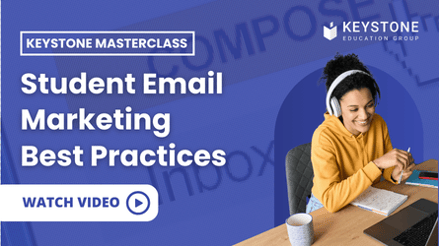- SERVICES
- HIGHER EDUCATION MARKETING
- ENGAGEMENT & ENROLLMENT MANAGEMENT
- STUDENT RECRUITMENT AGENCIES
- PROFESSIONAL EDUCATION & TRAINING
- WHO WE ARE
WHO WE ARE
Learn more about Keystone Education Group, including our leadership structure, why choose Keystone as your educational partner, and company press releases.
QUICK LINKS
- RESOURCES
RESOURCES
Find a range of helpful resources to help with your educational marketing. From on-demand webinars, reports & data, to customer testimonials and our downloadable media kit.
QUICK LINKS
- NEWS
- REQUEST A CALL

- Keystone Higher Education News
- What's New in SEO and Email for Higher Ed Marketers
With Google’s latest SERP algorithm and email updates, higher education marketers face new challenges in optimizing their online presence and ensuring their message reaches future students. Understanding these updates and their implications is essential for maintaining your visibility and relevance in search results.
Continue reading for a rundown of what every higher ed marketer needs to know about the recent changes, as well as tips for updating your email and content strategies.
Gmail’s and Yahoo’s Email Rules Update
With AI allowing companies to create and send promotional emails at a higher volume, Google and Yahoo have changed their email policy in favor of a stricter evaluation of email content, sender reputation, and engagement metrics.
This measure aims to preserve the user experience and reduce unwanted messages.
Now, Gmail authentication measures such as DomainKeys Identified Mail (DKIM), Sender Policy Framework (SPF), and Domain-based Message Authentication, Reporting & Conformance (DMARC) are vital in establishing your sender’s legitimacy. The introduction of Brand Indicators for Message Identification (BIMI) allows the inclusion of brand logos and enhances your credibility within authenticated emails.
Yahoo’s changes are similar, prioritizing user engagement and sender authentication, improving user experience, and ensuring that emails from authenticated sources successfully reach their intended recipients.
Essential Tips for Updating Your Email Strategy
To navigate the recent email changes effectively, follow these four considerations in creating your email campaigns:
- Strengthen authentication settings to ensure compliance with DKIM, SPF, and DMARC requirements.
- Stick to the limit of 5.000 emails per day to avoid jeopardizing your email delivery rates.
- Ensure your content is relevant to the recipient and optimized for user engagement to avoid being flagged as spam.
- Include easily accessible one-click unsubscribe links in all of your promotional emails to improve user experience.
While the new regulations primarily target bulk senders– that is, accounts that send over 5.000 emails per day– all professional accounts will benefit from complying with the updates.
By adhering to these regulations, your marketing and sales teams can improve email deliverability and avoid potential performance issues associated with non-compliance.
Ultimately, all you need then to optimize your emails’ deliverability is to create relevant and engaging content that resonates with your target audience and follows Google’s and Yahoo’s new guidelines.
Understanding Google’s Core Algorithm Update... and How it Applies to Higher Ed Institutions
In addition to its new email measures, Google has also changed its core algorithm, marking a shift in the search engine’s approach to ranking content. Like with the email updates, the new algorithm aims to enhance the user experience and provide more valuable search results by prioritizing firsthand experience and relevant and informative content.
The updated core algorithm emphasizes high-quality content, assessing how it demonstrates expertise, authoritativeness, and trustworthiness (EEAT)– concepts that every higher education marketer should understand to ensure their content reaches the highest number of prospective students. According to Google, EEAT stands for:
- (E)xperience: An assessment of how the author has firsthand experience on the topic in question. For example, prospective students looking for information on your university will give more credit to a personal account of a student who’s been on your campus than to an institutional brochure highlighting the school’s best selling points.
- (E)xpertise: According to Google’s definition, “different topics require different levels and types of expertise to be trustworthy.” Students aren’t always the best option to create content for their peers: if your prospective students are searching for information about the application process, they will benefit more from content made by an admissions staff member or a program coordinator.
- (A)uthoritativeness: An evaluation of your website’s credibility on the topic at hand. University websites are typically regarded as reliable sources on matters related to education, and your website’s authoritativeness can be further improved by publishing high-quality content by experienced and credible authors.
- (T)rustworthiness: Your accomplishments on the three previous concepts indicate your website’s overall trustworthiness, determining how safe, reliable, and accurate your pages are.
The update emphasizes firsthand accounts and credible sources, making user-generated content more important than ever. Now, users can filter search results by personal accounts, such as social media posts and forum entries.
Finally, in addition to the changes in SERP ranking, users now have the option to follow specific topics, which influences the content displayed on their Google mobile homepage.
How You Can Create High-Ranking Content for Your Institution
To ensure your university continues to rank highly in the face of the latest algorithm changes, you can implement several strategies to optimize your content:
- Showcase expertise and authority: Demonstrate your institution’s knowledge and leadership in your field through informative, well-researched content.
- Incorporate firsthand accounts: Share stories and experiences from students, faculty, and alums to provide authentic insights and build trust with your audience.
- Credit your authors appropriately: Make sure your content is credited to a single author, providing a detailed author biography and links to their social media profiles.
- Leverage HTML tags and Schema markup: Optimize your content with structured data to improve visibility and enhance search engine understanding.
- Collaborate with influencers: Partner with industry experts, known personalities, and thought leaders to amplify your message and reach a broader audience.
- Monitor and adapt: Stay vigilant about changes in search algorithms and continuously refine your content strategy to remain competitive in search rankings.
In sum, prioritize high-quality content and continuously optimize your on-page SEO elements, and you should have no major issues with the latest core algorithm update from Google.
Related Tags
Just For You
Top Picks
Higher Ed Chats Podcast
Listen to the latest episodes of our Higher Ed Chats Podcast. Hear from Higher Ed thought-leaders from around the world!
The Keystone Awards 2026:
Nominate your institution or a student

Recognize your your university, team, colleagues and students for a Keystone Award!
Subscribe
to get the latest news and updates



